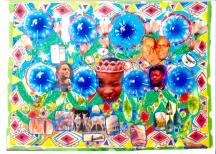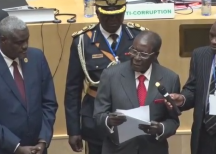
Despite accompanying debates about supposed non-white mediocrity, resistance to affirmative action is not about maintaining standards but rather about maintaining ‘white mediocrity’, argues Lewis R. Gordon.
Henry Louis Gates Jr., the famed African-American literary scholar and director of the Du Bois Institute at Harvard University, recently reflected the following in an interview on National Public Radio: If it weren't for affirmative action, he would not have been admitted to Yale University, regardless of how high his credentials were and he would not have had the opportunities to demonstrate his talent over the past four decades.[1]
Gates' admission reflects a fundamental problem with affirmative action. It works.
I had the opportunity to reflect on that out loud in a discussion at the Race and Higher Education conference in Grahamstown last month when I asked: ‘Are there no mediocre white people in South Africa? Is every white person hired, every white person offered admission to institutions of learning, an excellent candidate?’
My rhetorical question was premised upon what Gates and many other highly achieved blacks know and that is the myth of white supremacy is the subtext of the ‘qualifications’ narrative that accompanies debates on affirmative action.
When I was tenured at Brown University, the process required evaluations of my work from five referees. Expected performance was a published monograph, several articles, satisfactory teaching, service and signs of international recognition. My dossier had the following: three monographs (one of which won a book award for outstanding work on human rights in North America), an edited book, a co-edited book, 40 articles (several of which had gone in reprint in international volumes), two teaching awards and service that included heading a committee that recruited 23 scholars of colour to the university. The process for my promotion and tenure was dragged out because of continued requests for more referees. The number grew to 17.
There was a comparable white candidate in the philosophy department. He also supposedly worked in existentialism, one of my areas of expertise. His dossier? A contract for his dissertation and a few articles. His case was successful. His contracted dissertation was published several years later. He has since then not published a second book. He is now a full professor at that institution. Over the years, I have only met one person in his field who knew of and spoke well of his work. That person was a classmate of his in graduate school.
Was affirmative action necessary for my promotion and tenure? Yes. But as should be evident in this example and no doubt Gates' and many others, there is another truth. Was investment in white supremacy necessary for less than stellar whites to be promoted? Yes.
Affirmative action, which brought people of colour to the table to learn first-hand about the level of performance of their white predecessors and contemporaries, stimulated a reflection on standards in many institutions. As more people of colour began to meet inflated standards, what were being concealed were the low standards available to the whites who preceded them (and no doubt many who continue to join them as presumed agents of excellence).
So, what is the truth about the qualifications narrative, the claim about having to lower standards for the admission of people of colour? It masks racial hegemonic mediocrity.
There is another truth. There are few systems that depend on excellence to function. Most of the services we rely on to get through our lives depend on average levels of performance. And that's pretty much it. The rewards lavished on many whites in the modern world have not been based on merit. What many people of colour discovered upon entering those previously closed corridors was not white superiority but, for the most part, white mediocrity.
Now, to preserve such a system, what is often brought up is the mediocrity of blacks and other groups of colour who enter. What is not brought up, however, is the group of blacks and brown people who were excluded on the basis of their excellence. The prevailing view in predominantly white institutions about such candidates is fear of whether such candidates are ‘controllable’. Yes, that is the word that is often used behind closed doors.
Although I mentioned blacks and other people of colour, this concern of controllability is almost exclusively used for blacks and it is especially so for black males. Women fall under the rubric of affirmative action as well. The success of affirmative action is evident with gender, but, as is also clear, that is the case primarily with white women. Black and brown women are harder cases, but in recent times, the logic of controllability, with all its sexist connotations, has found a home with gender, where it remains until women seek leadership roles. There are exceptions, but in truth, real power, which means not what is seen in public, but what is behind closed doors, the power behind power, remains categorically male and white.
Keeping institutions white and predominantly male is not only about tests and evaluating dossiers. It's also about creating obstacles rationalised as important criteria. Consider the story of James Weldon Johnson, the famed novelist and song writer of, among other great works, ‘Lift Every Voice and Sing,’ known as the black national anthem. Johnson was also a lawyer. How he became one changed the criteria for the American bar admissions. He became one the way Abraham Lincoln became a lawyer. He took the bar examination. At that time, it did not require a law degree. It did not even require a bachelor's degree. The sole requirement was passing the examination. Doing so meant that one mastered the required understanding of the law to practice it.
Johnson, a secondary school principal, showed up to take the Florida bar exam in 1897. Seeing he was black and realising there was no rule stating that blacks couldn't take the exam (since they had presumed no black either would dare show up to take it or could take and pass it), he was permitted to take the exam. As it became clear he knew the law, his examiners inflated the standards and tested him at several times the expectation of the white candidates. One of the examiners left the room out of protest to the possibility of a black man passing the exam. Reluctantly, the others capitulated and he was sworn in as a member of the Florida bar.[2] Other blacks followed in droves.
We know what happened next. First, there was the bachelor's of law. Since many blacks couldn't afford to go to college, that reduced the pool by a significant number. But since there was a growing black middle class, even with American apartheid, more began to meet that criterion. So, the American Bar Association then required post-graduate study. To sit for the exam, a candidate must now have completed law school, which is, for the most part, three years of study after completing an undergraduate degree. In effect, seven or more years of investment in higher education became the criterion to sit before the bar. The stratagem was effective: the number of blacks qualified to take the bar examination plummeted.
This story of increased obstacles is also one of great social costs. If one considers the damage to institutions of legalised white supremacy done by the small cadre of blacks who met the additional criteria, imagine what would have happened if their ranks were larger? Nelson Mandela studied law, but what might have been the case if he were joined by a large number of comrades who were not only armed with the knowledge of law, but also with the credentials to act on it?
Law is but one example: there are many cases across a variety of professions, disciplines and activities ranging from political participation to sports.
What a genuine commitment to affirmative action would demand under circumstances such as the ones outlined here, then, is not only the insistence of inclusion, but also a critical reflection on the purposes of articulated criteria. Criteria should be created for the healthy function of an institution, which will entail just practices of exclusion. But, as we know, in a society committed to injustice, it is very easy to create unjust practices of exclusion.
So, we come to another problem with affirmative action. Its existence is the admission of continued racism and sexism.
In the United States, the bad faith language of denial has hijacked the language of affirmative action. The expression ‘past discrimination’ dominates debates. Past discrimination? If racial and gender discrimination were aberrations of the past, that would mean that no overseer of criteria is any longer motivated by racist and sexist goals. It would mean there is no racial or gender discrimination, which would make the use of race or gender as criteria unjust. It would be prejudice. Yet, as we know, the language of ‘reverse discrimination’ emerged in the US. Such language turned the tables on the situation. In effect, it made discrimination a reality faced only by white males precisely through denying the continued existence of racism and sexism.
We come, then, to an observation made by Frantz Fanon. Although he detested violence, as his former student and friend Alice Cherki reminds us in her poignant portrait of his life and thought, he did not shy away from speaking the truth about tolerated violence under colonial regimes and the strange logic of what he called the ‘Greco-Latin’ pedestal of supposed moral objections against decolonial movements.[3] Since colonialists regarded colonialism as just, how, then, could they be expected to see decolonisation as anything but unjust? If the ongoing efforts needed to maintain colonialism were considered just, how, then, could they be considered violent? That became a charge made against efforts to dismantle colonialism. And relatedly, if the exclusion of colonised people were considered just, then, would not their inclusion be considered unjust? Even worse, the appearance of such people was considered more than unjust. It was considered violent.
Fanon argued that the effort to demonstrate non-violent change was futile. By this, he did not mean that one should aim to be as violent as possible. His point was a negative one: the only way to satisfy the expectations of non-violence was to be ineffective at practices of social change. We forget that Martin Luther King Jr., one of the apostles of non-violence, was considered violent in his day. When fellow protesters and he marched against American apartheid, it was not the police officers who set German shepherds on them, not the hoards of whites who stoned them, not the fire fighters who sprayed them with water at a force capable of stripping skin, not the gangs who lynched many of them; it was not those people and agents of state power who were considered violent. What supporters of the status quo ‘saw’ was violent black people against whom the society was being protected.
The situation is familiar to many in South Africa. There are those who praise South Africa for making the transformation to a supposedly post-apartheid society non-violently. Without violence? The many blacks (in the Black Consciousness conception) and their supporters who were killed, tortured and imprisoned; the many protesters harmed; the tanks; the guns; the dogs; the 3 AM knock on the door; the many instances of trauma, none of them count? What is hidden in this misguided notion, as with what is suppressed about racism and sexism in the anti-affirmative action rhetoric of reverse discrimination and qualifications, is this: in a white supremacist state, violence is only recognised if it is waged against whites.[4]
So, the hysteria about crime, about insecurity in South Africa is, as no doubt everyone knows, similar to the same in the United States. Even when the actual figures of violent crime declined, incarceration of blacks was high, because there was, in effect, the criminalisation of a people. As violent appearance, black visibility was criminalised.
An odd feature of post-colonial states is that criminalisation of black populations doesn't require white institutional leadership. In so-called black countries, the phenomenon is there and it is colour-dependent, where darker-skin blacks are the most criminalised. The reasons for this are manifold, but most amount to the near isomorphic relationship between closed social options and skin colour as a legacy of racialised slavery and colonialism in the midst of post-colonial environments heavily invested in keeping capital in the hands of the former governing population.
The correlation between anti-affirmative action and the preservation of colonial institutions of exclusion and violence emerges because both rely on the same things – namely, racist states and civil societies. In fact, ‘uncivil society’ becomes the inclusion of the black masses.
There isn't enough space to discuss why the existence of black leadership in South Africa and in the United States does not harm a white supremacist state. I will leave that for another time. For now, I will just say this: Loving Nelson Mandela and Barack Obama is not requiring the same for black people. One need simply make them ‘exceptions’ to the rule in a world where black failure is the norm. Their existence can, thus, be subverted, ironically, for the preservation of a racist system, however noble their individual intentions are. This has been a difficult problem of black achievement from the moment anti-black racism emerged. Such blacks face having to succeed, even where their success is undermined as exceptions to a rule. Mandela and Obama did not get rid of white supremacy, but we have a sense that the world would be much worse off without them.
And there is the irony of the situation of each black person who manages to scrape through and rise in a system premised upon black suppression. There will always be objection to the presence of such people, as the uproar to the emergence of a paltry black middle class across the globe attests. Where millions of affluent whites don't occasion a raised eyebrow, the existence of thousands – but not even a million – rich blacks in countries with populations exceeding 40 million people leads to outcries with often hypocritical concerns about class. There are even objections about where such affluent blacks live. A recent study at Brown University provided an answer: For the most part, affluent blacks live in predominantly black and brown neighbourhoods with lower overall opportunities.[5] And why is this so? In the end, affluent whites, although welcoming the idea of integrated neighbourhoods, prefer to live in segregated places in practice. Even white lower middle-class and working-class people have access to neighbourhoods with more resources and possibilities of accrued wealth than many blacks with higher incomes. None of this is news to black middle-class people. As with the affirmative action debate, the truth here could be denied only through closing one's eyes to the continued practice of racism at institutional levels.
This is not to say that there is no excellence among rewarded whites. It is to say that, as with every group, high performance is by definition a virtue of those who are devoted and talented. But as Anna Julia Cooper had shown, far too much is invested in those who fail to meet such traits in white supremacist society.[6] Very little is put toward those who, with few incentives, produce more. Could one imagine what proper social investments in the people who are resourceful enough to survive in the shacks of South Africa, the favelas of Brazil, the slums of India and the ghettoes of the United States could mean for the future of humankind?
To make some headway on these matters demands, then, bringing to the fore the truth about affirmative action and the so-called post-apartheid world in which we now live. It requires admitting the onus of past victories is the next stage of struggle, a reality that, unfortunately, never fails to come, but whose battle must be waged, however weary our souls may be, because, as many of us in higher education know and those who sacrificed their lives to make access to it possible knew, what is at stake is no less than humanity's most precious resource, which speaks, in the end, to the future of all.
BROUGHT TO YOU BY PAMBAZUKA NEWS
* Lewis R. Gordon is the Laura H. Carnell professor of philosophy and Jewish studies and director of the Center for Afro-Jewish Studies at Temple University, in Philadelphia, Pennsylvania.
* This article was first published by Truthout.
* Please send comments to editor[at]pambazuka[dot]org or comment online at Pambazuka News.
NOTES
[1] See the interview, ‘What It Means To Be “Black in America”,’ in the program Fresh Air (27 July 2011).
[2] See James Weldon Johnson, ‘Along This Way: The Autobiography of James Weldon Johnson’ (New York: Penguin Classics, 2008), p. 143.
[3] Alice Cherki, Fanon: ‘A Portrait,’ trans. Nadia Benabid (Ithaca, NY: CornellUniversity Press, 2006).
[4] For elaboration, see my colleagues' and my chapters in ‘Biko Lives!: Contestations and Conversations,’ edited by Amanda Alexander, Nigel Gibson and Andile Mngxitama (New York: Palgrave, 2008); and ‘Living Fanon: Global Perspectives,’ edited by Nigel Gibson (New York: Palgrave, 2011).
[5] See John Logan, ‘Separate and Unequal: The Neighborhood Gap for Blacks, Hispanics and Asians in Metropolitan America,’ US 2010 Project Report (08/02/2011).
[6] See her essay, ‘What Are We Worth?' in The Voice of Anna Julia Cooper: Including A Voice From the South and Other Important Essays, Papers and Letters,’ edited by Charles Lemert (Lanham: Rowman & Littlefield, 1998).
- Log in to post comments
- 2640 reads



































